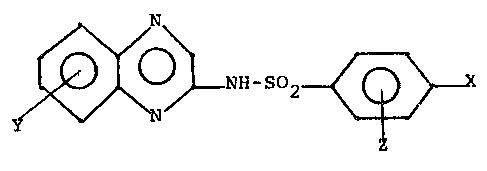Note: Descriptions are shown in the official language in which they were submitted.
~7~
2986P/0862A
17276
TITLE OF THE INVENTION
METHOD FOR TREATING NEOPLASTIC DISEASE
BACKGROUND OF THE INVENTION
The present invention relates generally to
sulfonamido derivatives of sulfanilamido quinoxaline
of formula I and the use of such compounds in the
treatment of neoplastic disease states in animals
including humans.
Per~inent to the background of this
invention is the compound 2-~4-aminobenzenesulfon-
amido~-quinoxaline also known as sulfaquinoxalin
which has been used as a coccidiostat in the
prophylactic treatment of chickens and other fowl to
prevent the onset of coccidiosis disease. Also
pertinent to the present invention is an article
published by F. J. Wolf et al., Substituted
Sulfa~inoxalîne III Extension o~ the Glyoxalate
Synthesis of 2-Aminoquinoxaline, J. Am. Chem. Soc.
.
2986P/0862A - 2 - 17276
71, 6-10 (1947) which describes the synthesis of a
number of similarly substituted sulfaquinoxaline and
a general method of synthesis for such compounds by
reaction of the substituted 2-aminoquinoxaline
compound with a p-acetylaminobenzenesulfonyl chloride
to produce the substituent of the 2-N4-acetyl-
sulfanilamide quinoxaline and hydrolyzing said acetyl
compound by heating with 2.SN aqueous sodium
hydroxide to produce the desired 2-sulfanilamido
substituted quinoxaline.
DESCRIPTION OF THE INVENTION
In accordance with the present invention a
compound of formula I hereinbelow:
~ O ~ NH-SO
wherein:
X is a substituent selected from -NO2, -NH2,
NH -R, NH-tCH2)n-COOH or NHCH2SO3H;
wherein R is lower alkyl or phenyl and N = 1
to 6;
Y is a substituent attached to any carbon in the
~uinoxaline ring selected from NH2,
OCH3, halogen ~including chloro, bromo and
fluoro), -CH3, OH; and
Z is hydrogen or halogen;
is mixed with a non-toxic pharmaceutical carrier and
divided into uni~ doses, each dose containing an
~2~7~
2986P/0862A - 3 - 17276
effective neoplasm-inhibiting amount of the selected
sulfonilamidoquinoxaline to produce a pharmaceutical
composition effective in treating neoplasm disease
and administering said composi~ion to the animal host
having a neoplasm disease condition.
Preparation of Active Compounds
The compounds active as antineoplastic
agents of formula I hereinabove are prepared in
accordance with the procedure set forth in the
article by F. J. Wolf et al., Substituted
Sulfaquinoxaline III Extension of the Glyoxalate
Synthesis of 2-Aminoquinoxaline, J. Am. Chem. Soc.
71, 6-10 tl947). The process described therein
comprises treatment of an appropriately substituted
2-aminoquinoxaline with a p-nitro- or p-acetylamino-
benzenesulfonyl chloride in dry pyridine and if
desired to produce the corresponding 2-(4-nitro-
benzenesulfonylamido~quinoxaline or the 2-N4-acetyl-
sulfanilamidoquinoxaline and if desired hydrolyzingthe N-acetyl compounds to produce the corresponding
2-sulfanilamidoquinoxaline as illustrative herein
below:
25 ~HCOCH3 No2
H2
2Cl SO2Cl
~ 676~9~
2986P~0862A - 4 - 17276
2 ~ O -N ~ Y
or
CH3Co-NH ~ _502NH 4 ~ ~
2N~02~N~O~Y
Compounds prepared in this manner are:
MP
2-(4-nitrobenzenesulfonylamido)-quinoxaline
2-sulfanilamido-quinoxaline
2-sulfanilamido-6 (or 7)-methyl quinoxaline a 215-16C
2-sulfanilamido-6 ~or 7)-methyl quinoxaline b 255-56C
2-sulfanilamido-6 (or 7)-chloro quinoxaline a 248-49C
2-sulfanilamido-6 (or 7)-chloro quinoxaline b 238-39C
2-sulfanilamido-6 (or 7)-bromo quinoxaline a 244-46C
2-5ulfanilamido-6 (or 7)-bromo quinoxaline b 239-40C
2-sulfanilamido-6 (or 7)-nitro quinoxaline a 220-21C
2-sulfanilamido-6 (or 7)-nitro quinoxaline b 224-26C
2-sulfanilamido-6 (or 7)-amino quinoxaline a 275-76C
~7~
2986P/0862A - 5 - 17276
2-sulfanilamido-6 (or 7)-methoxy quinoxaline a 23~-40C
2-sulfanilamido-6 ~or 7)-methoxy quinoxaline b 235-37C
2-sulfanilamido-6 (or 7)-carboxy quinoxaline b 223C
2-sulfanilamido-5 (or 8)-methyl quinoxaline a 205-06C
2-sulfanilamido-5 (or 8)-methyl quinoxaline b 192-94C
2 sulfanilamido-5 (or 8)-methoxy quinoxaline b 105C
*2~sulfanilamido-5-chloroquinoxaline b 213-15C
2-sulfanilamido-5-methyl-6-chloro-8-isopropyl-
quinoxaline b and isomer 92-115~C
In the preceeding list of compounds a refers to
the lower melting isomer and b to the higher melting
isomer.
The therapeutic methods of the present
invention comprise the administration of ef~ective
amounts of one or more of the compounds of Formula I
as an active ingredient together with desired
pharmaceutically acceptable diluents, adjuvants and
carriers to an animal suffering from a neoplastic
disease state. Unit dosage forms of compound of from
0.1 to 500 mg are administered according to the
methods of the invention. Such unit dosage forms may
be given to provide a daily dosage of Erom 10 to 500
mg/kg of body weight of the animal to be treated.
Parenteral administration and especially intra-
peritoneal administration is the preferred route for
practice of the invention methods.
` The following examples are for illustrative
purposes only and are not considered limiting the
invention.
* The structure of this compound was determined
absolutely by X~ray spectroscopy.
67~
2986P/0862A - 6 - 17276
EX~MPLE 1
In Vitro Activity of 2-Sulfanilamido-5-chloro-
quinoxaline
Tests carried out in accordance with the
procedures described in Cancer Research 45, 2145-53,
May 1985, Application of a Human Tumor Colony-formin~
Assay to New Druq Screenin~ - Shoemaker et al.
Colony Forming Assay Response Rates
For 9 Tumor TYpes
Dose meq/ml
Tumor Type 10 1 0.1
Breast 2/6 (33.3%) 1/4 ~25~) 0/4 t0%)
Colorectal 2/10 (20%) 2/10 (0%) 0/10 (0%)
Kidney 3/10 (30%) 1/4 (11.1%) 0/0 (0%)
Lung 5/11 (45%) 3/8 (38~) 1/8 (13~)
Melanoma 4/13 (30.8%) 2.8 (25%) 0/8 (0%)
Ovary 6/16 (37.5%) 0/9 (0%) 1/7 (14 3%)
Sarcoma 1/1 (100%) NT NT
Skin 0/1 (0%) NT NT
Uterine 1/2 (50~)NT NT
.
Total for all tumors at 10 meq/ml - 24/70 (34.3%)
Total for all tumors at 1 meq/ml - 7/48 (14.6%)
Total for all tumors at 0.1 meq/ml - 2/47 (4.3%)
.
Response = = 70% cell kill at = 10 meq/ml
NT - Test faulted and experiment not included
~67~
2986P/0862A - 7 - 17276
EXAMPLE 2
In Vivo Activity of 2-Sulfanilamido-5-chloro~
quinoxaline
The test for antitumor activity in vivo
using a new human tumor xenograft model, the LOX
amelanotic melanoma in mice showed a significant
increase in the life span of mice when treated with
: the title compound in doses of 449, 300 and 200
mg/kg/day.
!
: 30
